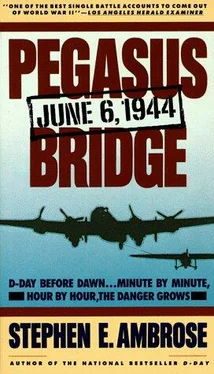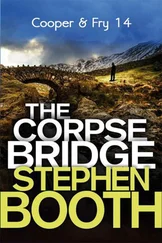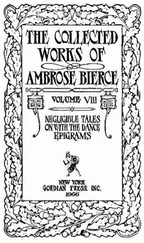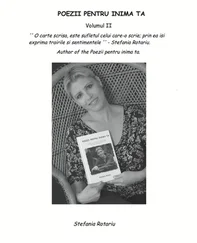Stephen Ambrose - Pegasus Bridge
Здесь есть возможность читать онлайн «Stephen Ambrose - Pegasus Bridge» весь текст электронной книги совершенно бесплатно (целиком полную версию без сокращений). В некоторых случаях можно слушать аудио, скачать через торрент в формате fb2 и присутствует краткое содержание. Жанр: История, на английском языке. Описание произведения, (предисловие) а так же отзывы посетителей доступны на портале библиотеки ЛибКат.
- Название:Pegasus Bridge
- Автор:
- Жанр:
- Год:неизвестен
- ISBN:нет данных
- Рейтинг книги:5 / 5. Голосов: 1
-
Избранное:Добавить в избранное
- Отзывы:
-
Ваша оценка:
- 100
- 1
- 2
- 3
- 4
- 5
Pegasus Bridge: краткое содержание, описание и аннотация
Предлагаем к чтению аннотацию, описание, краткое содержание или предисловие (зависит от того, что написал сам автор книги «Pegasus Bridge»). Если вы не нашли необходимую информацию о книге — напишите в комментариях, мы постараемся отыскать её.
Pegasus Bridge — читать онлайн бесплатно полную книгу (весь текст) целиком
Ниже представлен текст книги, разбитый по страницам. Система сохранения места последней прочитанной страницы, позволяет с удобством читать онлайн бесплатно книгу «Pegasus Bridge», без необходимости каждый раз заново искать на чём Вы остановились. Поставьте закладку, и сможете в любой момент перейти на страницу, на которой закончили чтение.
Интервал:
Закладка:
One evening, an excited corporal reported that he had just stolen a British truck, jammed with tinned meat and other delicacies. Von Luck looked at his watch - it was past 6 p.m. -and told the corporal he would have to take it back, as he had captured it after 5. The corporal protested that this was war and anyway the troops were already gathering in the goods from the truck. Von Luck called Rommel, his mentor in military academy. He said he was suspicious of British moves further south and thought he ought to go out on a two-day reconnaissance. Could another battalion take his place for that time? Rommel agreed. The new battalion arrived in the morning.
That night, at 5:30 p.m., just as von Luck had anticipated, the British stole two supply trucks.
Heinrich Hickman, meanwhile, had gone through the campaigns in Holland, Belgium and France of 1940 as a gunner on an 88mm gun. In 1941, he volunteered for the parachute regiment, and went to Spandau for jump school. In May, 1942, he was in the middle of his training.
In Warsaw, Vern Bonck was doing his best to stay out of the German conscription net by working with extra efficiency at his lathe. Helmut Romer, fourteen years old, was finishing his school year in Berlin.
At the bridge over the Caen canal, there were as yet no elaborate defences, and only a tiny garrison. Still, the garrison was large enough to make the lives of the people ofBenouville, Le Port, and Ranville miserable. The Germans helped themselves to the best of everything, paid for what they did purchase with nearly worthless printing-press francs, took all the young men away for slave labour, made travel even within the country almost impossible, imposed a curfew, and shot dissenters. By May, 1942, the Gondrees had decided to do something about it. Georges joined the local Resistance, which advised him to stay put and use his situation to gather information on the bridges and their defence. This he could easily do on the basis of what his wife heard in the cafe. Let there be no mistake about this action - the Gondrees knew that if the Germans caught them, they would be first tortured, then hanged. But they persisted.
In May, 1942, Jim Wallwork was also in training camp. Jim was a Manchester lad who had volunteered for the army at age 19, in 1939. His father, who had been an artilleryman in the Great War, had advised him, 'Whatever you do, Jim, don't for God's sake join the infantry. Get in the artillery, the biggest gun you can find; if possible, the railway gun.' Naturally, Jim ended up in the infantry, bored to tears, although he did make it to sergeant. He tried to transfer out, into the Royal Air Force, but his commanding officer blocked the move because he wanted to keep Wallwork with him.
Then in early 1942, when a call went out for volunteers for the Glider Pilots Regiment, Jim signed up. By spring he was training at Tilshead, Salisbury Plain. 'It was rather rough', he recalled, 'because I was doing my own equipment, polishing my own brass, going on those God-awful run-marches, and drills, and all sorts of that nonsense.' What he most feared, what every man in the Glider Pilots Regiment most feared, were the letters, 'RTU'. They stood for Return to Unit, and they meant disgrace, failure. Jim managed to stick it, and by May, 1942, he was at flight training school, learning to fly a small aeroplane.
Howard's own family was growing. Joy, living with relatives at Church Stretton, was pregnant. During the war Howard was a virtual teetotaller, partly because he wanted to keep a clear mind, partly because 'I saw the mess a lot of people were getting into, making bloody fools of themselves, and I wanted to set an example for my own subalterns'. The child was due in late June but not actually born until July 12. During the fortnight between the due date and the actual delivery, Howard was so irritable and bad-tempered that his subalterns found him unapproachable. When news of the successful delivery arrived in Bulford, everyone was so relieved that a huge party developed. Howard, drinking straight shots of whisky 'to wet the baby's head', got royally drunk.
By July, Howard was pretty much on his own, allowed by his colonel to set his own training pace and schedule. Initially he put the emphasis on teaching the men the skills of the light infantryman. He taught them to be marksmen with their rifles, with the light machine-gun, with the carbine and the pistol, with the Piat and other anti-tank weapons. He instructed them in the many types of grenades, their characteristics and special uses.
The basic weapons of a gliderborne platoon of thirty men included the Enfield .303 rifle, the Sten carbine, the Bren light machine gun, 2" and 3" mortars, and the Piat (projector infantry anti-tank). The Enfield was the old reliable British rifle. One or two men in each platoon were snipers, each equipped with a telescopic sight for his rifle. The Sten was a 9mm submachine gun that reflected Britain's inability to produce quality weapons for her troops. The Sten was mass-produced, and distributed to thousands of fighting men, not because it was good but because it was cheap. It could be fired single-shot or automatic, but the weapon frequently jammed and too often it went off on its own. In 1942 David Wood accidentally shot Den Brotheridge in the leg with his Sten, in fact, after forgetting to put the safety-catch back on. Brotheridge recovered, and indeed he, like all the officers, carried the Sten by choice. Weighing only seven pounds and measuring thirty inches in length, it had an effective range of a hundred yards and used a box magazine holding thirty-two rounds. For all its shortcomings, it was deadly in close-in combat - if it worked.
The Bren gun was a light machine gun, weighing twenty-three pounds, normally fired on the ground from a tripod, but also from the hip. It had an effective range of 500 yards and a rate of fire of 120 rounds per minute. There was one Bren gunner per platoon; everyone in the platoon helped carry the thirty-round magazines for him. In rate of fire, in depend ability, and by other measurements, the Bren was inferior to its German counterpart, the MG 34, just as the Sten was inferior to the German Schmeisser.
The Piat was a hand-held rocket, fired from the shoulder, that threw a three -pound bomb through a barrel at high trajectory and a speed of about 300 feet per second. The hollow charged bomb exploded on impact. Effective range was supposed to be 100 yards, but the men of D Company could never get more than 50 yards out of the Piat. Being spring-loaded, Piats were inaccurate and subject to frequent jamming. They also had a nasty habit of glancing off the target unexploded. No one liked them very much, but all got proficient with them.
They all also learned to use a Gammon bomb, a plastic explosive charge developed from the 'Sticky Bomb' and designed by Captain Gammon of the paratroopers. You could throw one with a stick and it would cling to the clogs of a tank, or even throw it by hand (as long as it did not stick to the hand). Except for the Piat, Gammon bombs were all a glider platoon had to fight tanks, and the men learned what they had to know about them. Much of the training was with live ammunition, which caused some accidents and an occasional death, but the British had learned from Dieppe that it was essential to expose green troops to live ammunition before sending them into combat.
Howard taught his men about German weapons, how to use them, what they could do. He taught them how to lay and find mines, how to take them up. He gave them a working knowledge of elementary first aid, of cooking in a billy can, of the importance of keeping clean. He made certain that they could recognise the smell of various poison gases, and knew what to do if attacked by them. He insisted that every man in his company be proficient in the use of natural and artificial camouflage, and know how to read a topographical map. His men had to know how to use a field wireless, how to drive various army vehicles. Most of all, Howard put the emphasis on teaching them to think quickly. They were elite, he told them, they were glider-borne troops, and wherever and whenever it was that they attacked the enemy, they could be sure of the need for quick thinking and quick response.
Читать дальшеИнтервал:
Закладка:
Похожие книги на «Pegasus Bridge»
Представляем Вашему вниманию похожие книги на «Pegasus Bridge» списком для выбора. Мы отобрали схожую по названию и смыслу литературу в надежде предоставить читателям больше вариантов отыскать новые, интересные, ещё непрочитанные произведения.
Обсуждение, отзывы о книге «Pegasus Bridge» и просто собственные мнения читателей. Оставьте ваши комментарии, напишите, что Вы думаете о произведении, его смысле или главных героях. Укажите что конкретно понравилось, а что нет, и почему Вы так считаете.




![Stephen Ambrose - Citizen Soldiers [Condensed]](/books/346737/stephen-ambrose-citizen-soldiers-condensed-thumb.webp)




